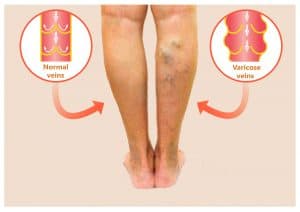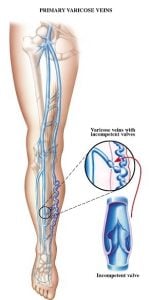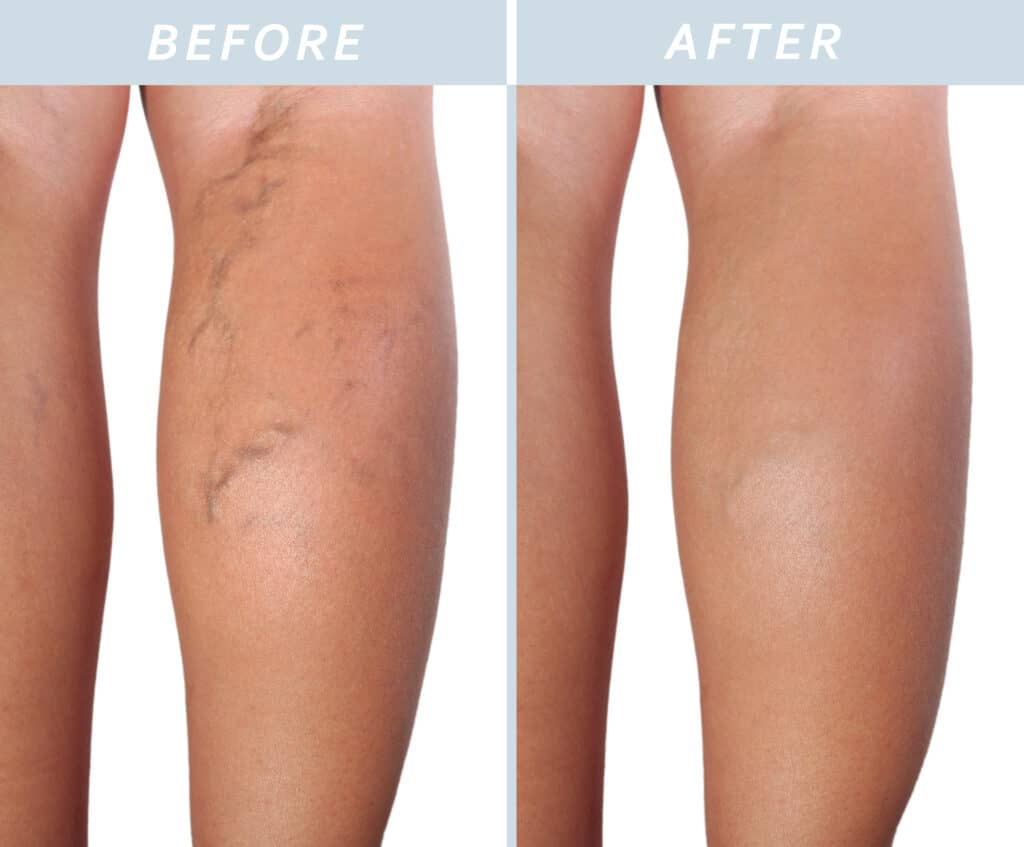Microphlebectomy Vein Treatment

Microphlebectomy is the minimally-invasive removal of varicose veins.
Have a varicose vein that you just can’t stand? In most cases simply removing it is the best option. This is known as a Microphlebectomy (“Micro” = small, “phleb” = vein, and “ectomy” = removal).
Because varicose veins aren’t working properly, mid to large-sized varicose veins actually do more harm than good. The valves within varicose aren’t working properly, which allows blood to flow back down the legs. This is why varicose veins sufferers often complain of heavy, aching legs.
1 Hour Office Procedure for Beautiful legs!

The microphlebectomy procedure takes about 1 hour and is usually done in your doctor’s office. This is primarily because it’s so safe. The main reason for this is that being “put under” with general anesthesia isn’t necessary. This also means no overnight stay, or even observation time, in most cases.
Local anesthetics similar to those used in a dentist’s office are used instead. Most patients report feelings of pressure put no pain. If patient anxiety is an issue, then medications can be prescribed to be taken before the procedure. Most describe the process as quick and easy when asked about it afterwards. They then usually go on to mention how great their legs look and feel.
Microphlebectomy has Little Risk!
A Microphlebectomy is minimally invasive, and carries almost no risk. Minor bruising is common, which will subside quickly. There will likely be some temporary swelling and discomfort at the incision sites. This is short-lived and can be managed with over-the-counter medications such as Tylenol (acetaminophen) if needed. The chances of even minor complications such as infections is very low. In virtually all cases, the benefits of receiving this procedure outweigh the negligible risks.
Commonly referred to as ambulatory phlebectomy, this surgical procedure is the removal of varicose veins that are too painful and superficial to be treated via ELVA (Endovenous Laser Vein Therapy). Microphlebectomy is often combined with EVLA, and has a high rate of effectiveness because it completely removes the varicose vein. It is performed under local anesthesia and does not require stitches or sutures.
Before a Microphlebectomy Procedure
Before the procedure, the doctor will conduct an ultrasound exam of the treatment site to identify which veins will be removed. A skin marking pen will be used to identify the sites on the patient’s leg.
Microphlebectomy will remove the diseased portions of veins. The varicose veins will be pulled out through the small needle puncture sites under local anesthesia.
The punctures will be covered with steri-strips, if needed, following surgery. Sutures and staples are not necessary. Bandages and stocking will be applied to the problem area. Your health care team will have you walk on the treadmill before being discharged. You may drive after the procedure. A follow-up visit will be needed to re-examine the treatment site.
Microphlebectomy Alternatives
The Microphlebectomy is generally regarded as a “good” procedure by surgeons. Related vein procedures such as RF ablation and the more recent “Vein Glue” treatment are, as well. So what makes a treatment “good” in the mind of a surgeon? It does exactly what it’s supposed to do with little or no collateral damage. These minimally-invasive procedures are in stark contrast to Vein Stripping. Most surgeons regard this procedure as potentially doing more harm than good. It is now rarely performed due to newer and better treatments.

Microphlebectomy Benefits
The Microphlebectomy offers many benefits to almost all patients, yet shares none of the drawbacks of older procedures. The recovery period for a microphlectomy is limited to the time it takes for the small ¼ in access incisions to heal. Stitches aren’t required, so there’s no need for a return visit to have them removed. Patients can resume most normal, day-to-day activities like office work and driving immediately. Strenuous exercise like running and lifting weights can be started again in about 2 weeks.
The cosmetic results of a Microphlebectomy are immediately visible after any swelling and bruising have subsided. The relief of symptoms such as achiness can be felt at this point as well. Remember that the varicose vein in question has been removed. It’s possible for patients to develop other vein problems later, but for the treated vein the results of a Microphlebectomy are permanent, for all practical purposes.
What are the signs that microphlebectomy may be necessary?
Microphlebectomy may be necessary if you exhibit the following signs and symptoms:
Visible Varicose Veins: Large, bulging, and twisted veins that are visible on the surface of the skin, often on the legs.
Leg Pain: Persistent pain, aching, or discomfort in the legs, especially after standing or sitting for long periods.
Swelling: Swelling in the legs, ankles, or feet, which may worsen throughout the day.
Itching: Itching around the varicose veins or in areas where blood is pooling.
Skin Changes: Discoloration, thickening, or hardening of the skin near the varicose veins.
What kind of post-procedure care is required after microphlebectomy?
After undergoing a microphlebectomy, proper post-procedure care is essential to ensure optimal healing and minimize complications. Here are the key aspects of post-procedure care:
- Compression Stockings: Wear compression stockings as recommended by your doctor to reduce swelling, improve blood flow, and support the healing process. These are typically worn continuously for a few days and then during the day for a couple of weeks.
- Keep the Area Clean and Dry: Follow your doctor’s instructions for keeping the incision sites clean and dry. Avoid submerging the treated area in water (like baths or swimming) until the incisions have fully healed.
- Avoid Strenuous Activities: Refrain from heavy lifting, vigorous exercise, and standing for long periods for at least one to two weeks, or as directed by your physician.
- Elevate Your Legs: Elevate your legs when sitting or lying down to reduce swelling and promote circulation.
- Pain Management: Use over-the-counter pain relievers, such as ibuprofen or acetaminophen, as needed to manage discomfort. Follow your doctor’s instructions regarding any prescribed medications.
- Stay Active: Engage in light activities, such as walking, to maintain circulation and prevent blood clots. Avoid prolonged periods of inactivity.
Does the Microphlebectomy procedure work?

Yes. The microphlebectomy procedure is extremely effective when performed on the right patients. The cosmetic results are almost always excellent and achiness is reduced or eliminated. It’s also a permanent solution.
This procedure works well on the vast majority of patients with larger problem veins. Smaller veins can (and should) be treated with injection-based Sclerotherapy instead. The choice is simple, since Sclerotherapy is even less invasive than a microphlebectomy and accomplishes the same goal. Both get rid of unwanted veins for good.
In other cases, deeper veins which aren’t visible on the surface are the underlying cause of the problem. These can be treated effectively as well using other minimally-invasive techniques. If present, it’s best to treat these first. All of these procedures will likely be offered by the same facility, i.e. a vein or vascular center.
Total Removal of the Faulty Vein – The Best Solution
This will improve the surrounding circulation as blood is re-routed to nearby healthy veins. There’s no risk of “running out of veins”. Each leg has literally miles of small to mid-sized veins which return blood back up the leg towards the heart.
How long does the procedure typically take?
The duration of a microphlebectomy procedure can vary depending on the number and complexity of the veins being treated. Generally, the procedure itself is relatively quick and typically takes about 30 minutes to an hour to complete.
During microphlebectomy, small incisions are made over the varicose veins, and the veins are gently removed using specialized instruments. The procedure is often performed on an outpatient basis, meaning patients can usually go home the same day.
It’s important to note that the actual time spent in the clinic or hospital may be longer due to pre-operative preparations, such as marking the veins and administering local anesthesia. Additionally, if the patient has multiple veins to be treated, the overall procedure time may be extended accordingly.
The specific duration of the microphlebectomy procedure will be determined by the surgeon based on individual circumstances, including the size and location of the varicose veins. It is best to consult with a qualified vascular specialist or surgeon who can provide a more accurate estimate of the procedure time based on your specific case.
What Type Of Veins Microphelbectomy Treats?
Normally, microphelbectomy is best at treating medium to large veins which are located at the skin’s surface. Most of the times these veins are bulging, twisted and clearly visible and are a cause of either venous insufficiency or malfunctions in valves. But the thing with microphelbectomy is that, it’s best at treating larger veins, but it cannon treat severe issues, they might require vein stripping or other invasive treatments. Also, microphelbectomy is not suitable for problems like spider veins, or veins deeper in the body, it can treat only the visible veins that are near your skin’s surface. Lastly, most of the time microphelbectomy is used only for cosmetic concerns, but if you experience pain and discomfort, you can get it without any hesitation.
Can Patients Return To Work Right After Microphelbectomy Treatment?
No, not right after you are done with microphelbectomy, you must wait at least 1-3 days before you can continue. It’s because this procedure is minimally invasive, requires only few incisions, which makes it have a really small downtime. However, if you are someone who’s job requires heavy work then you should rest more than others after the treatment, because pressure or strain on the newly treated area can make the recovery process hard. Lastly, you will experience some minor side effects like bruising, discomfort and swelling, which will go away on their own gradually but it’s a good idea to let them resolve on their own while you rest.
Do Patients Need To Make Preparations Before Microphelbectomy Treatment?
Yes, your doctor might give you few instructions you should follow before the treatment. Most of the time these instructions include, not taking blood-thinning medications, wearing loose and comfortable clothing, not applying any lotions or creams on the treatment area. Also, feel free to talk with your doctor about your allergies, it helps them manage the treatment in the best way for you.
What is the success rate of microphlebectomy in treating varicose veins?
Microphlebectomy is considered an effective treatment option for varicose veins. While success rates can vary depending on various factors, including the severity and extent of the varicose veins, overall, microphlebectomy has shown high success rates in treating varicose veins.
The success of microphlebectomy is typically measured by the improvement in symptoms, cosmetic outcomes, and the prevention of further complications associated with varicose veins. It is commonly reported to provide significant relief from symptoms such as pain, swelling, and discomfort associated with varicose veins.
Studies have demonstrated success rates ranging from approximately 80% to 95% in terms of symptom improvement and patient satisfaction following microphlebectomy. The procedure has been shown to effectively remove the diseased veins, improve circulation, and restore healthier blood flow.
Restore Your Leg’s Appearance
The goal of a Microphlebectomy is restoring the leg to its original appearance. The only result should be the absence of the ugly, bulging, and often painful varicose vein. Most importantly, visible scarring is usually absent.
Experienced surgeons are trained to make such micro-incisions so that the edges align perfectly and scarring doesn’t occur. Often the necessary incisions can be hidden using lines and other pre-existing marks on the skin. This is one of many reasons why it’s essential to select a surgeon with extensive experience. If any minimal scarring does occur it tends to fade completely with time.
Microphlebectomy FAQ
In general, patients report very little discomfort. Many compare the feeling of the initial injection of the local anesthetic as a pinch or similar to a bee sting. In the vast majority of cases, patients don’t feel anything after that except for maybe a little pressure. The veins are not very deep in the leg and therefore far from any major nerves. While technically a surgical procedure, microphlebectomy is considered minimally invasive. It is not normally painful nor is there any reason to be frightened. We take great pride in putting our patient’s comfort first.
Since the needle holes are so tiny, sutures or staples are not required after a microphlebectomy. The possibility of scarring is minimal. If you carefully use sunscreen, and other techniques to limit sun exposure to the treated area in the months following the procedure, the marks will fade even faster.
The results of a microphlebectomy are overwhelmingly positive. Patients report a high level of satisfaction with very few instances of side-effects. By virtue of being a minimally invasive procedure that requires only local anesthesia, many of the possible pitfalls are avoided. Additionally, the puncture holes are so small, that the infection risk is greatly reduced. Adding to microphlebectomies’ incredible success rate is the addition of EVLA (Endovenous Laser Vein Therapy). After the damaged feeder vein is sealed off with a specialized laser, the varicose veins coming from it can more effectively be removed. When used together, microphlebectomy and EVLA offer a one two knockout punch to the varicose veins.
Those of us who suffer from varicose veins realize that they are not always simply a cosmetic worry. There are medical issues associated with them as well. For this reason health insurance may be able to help with treatment costs. Call the office today to set up your risk-free varicose vein evaluation at the Advanced Vein Center. Our dedicated healthcare insurance specialists, can check your benefits and preauthorize your procedure so you know you are covered- and there are no surprise bills!
Smaller veins can (and should) be treated with injection-based Sclerotherapy instead of a microphlebectomy. Sclerotherapy is less invasive than a microphlebectomy and accomplishes the same goal. Both get rid of unwanted veins for good.
Microphlebectomies work well on the vast majority of patients with larger problem veins.
Sclerotherapy uses injections to change the vein to allow it to be reabsorbed by the body. Phlebectomies remove the vein.
There is little to no recovery time needed. We recommend to our patients elevating their legs as much as they can the first 24 hours following their ambulatory phlebectomy. The phlebectomy site is not stitched closed, because it is such a small poke hole; however, gravity can cause leakage if you are too active. Leave the little bandaids or steristrips in place a few days until they fall off.
We allow our patients to resume light exercise within a week or two depending on their usual level of activity. Wear your stockings as recommended by your Vein Doctor, usually about 2-3 weeks during the day. During this time limit lifting heavy loads or straining.
Our Pittsburgh Vein Centers are located conveniently throughout the greater Pittsburgh Metropolitan area. We have a Vein Clinic in Bridgeville in the South Hills -Advanced Vein center. Cranberry Twp vein clinic is also nearby. All of these locations are full service vein centers around Pittsburgh. Our Monroeville Vein Clinic provides sclerotherapy, as does our Downtown Pittsburgh vein clinic. Check our location pages for more convenient Pittsburgh locations.
Usually the phlebectomy is covered by insurance if you qualify. If you are unsure, come in for a Doppler Ultrasound to see if your veins are bad enough to be covered and speak with our insurance specialists, who will answer your questions.
Microphlebectomies can cost, if out of pocket, $500-$2,500 a leg depending on where you live, how bad your legs are, and the amount of veins you want to treat. Luckily, phlebectomies are usually covered by insurance! As long as you meet medical necessity requirements phlebectomies are a covered service.
Varicose veins are often painful and limit the activities of your day. If it affects your quality of life, we can help.
A phlebectomy is a minimally invasive office procedure used to treat medium sized veins that are too small for ablations, but too big for sclerotherapy to work well. Another name for this procedure is Ambulatory Phlebectomy; this is because you can remove the moderate sized veins without an actual surgery.
Tylenol the next day is usually all that is needed following a microphlebectomy. During the procedure the Vein Doctor lightly numbs the area so you do not feel the procedure.
Most side effects, if you have any at all, are transient. Bruising in the area and occasionally short term numbness are possible but usually fade quickly.
You can usually return to your normal activities with in 24 hours. However don’t lift heavy weights for two weeks and you will need to wear 20-30 mm hg thigh high compression stockings for 2-3 weeks while avoiding strenuous exercise.
The actual damaged veins are taken out, so that particular vein cannot return! We usually recommend treating veins in a stepwise fashion. This would include ablating the larger veins first. This way the incompetent valves that caused the vein damage are removed prior to the phlebectomy, so it cannot make new ones.
There is always a 1-2% risk of infection any time you break the surface of the skin. Sometimes, if you are prone to scars or hyperpigmentation, the skin may remain discolored for a while in a 2mm area. Rarely, you could have a usually transient area of numbness and tingling, which usually lessens in several months. Bruising under the skin or bleeding from the small poke hole can also occur.
If you live in the South Hills of Pittsburgh, our vein Doctor is near you. He is well trained with many years of Vein experience. Appointments are usually available within a day or two and easily scheduled around your work schedule. We have a certified Vascular Lab as well as trained certified RVT’s-Registered Vascular Technicians who perform the Doppler Ultrasound exam.
Individuals with spider veins often experience swelling, throbbing, burning, cramping sensations, and leg fatigue. The level of symptoms varies from person to person. Many who do not experience any symptoms still choose to get the spider veins treated.
Treating spider veins can greatly reduce the following symptoms:
- Heavy and achy feelings in the legs
- Burning, throbbing, or muscle cramping
- Swelling of the lower legs
- Itchiness in the associated area
Multiple procedures are often combined. A typical example is a patient who first receives RF ablation to clear underlying vein disease. A Microphlebectomy will then be performed to remove remaining surface veins. Sclerotherapy or surface laser therapy may then be used to remove very small surface veins (spider veins).
Phlebectomy before and after photos:

Our Locations for a vein doctor near me:
- VEIN TREATMENT DOCTOR PITTSBURGH
- VEIN CLINIC PITTSBURGH SOUTH
- VEIN DOCTOR MOON TWP
- VEIN DOCTOR CRANBERRY TWP
- VEIN DOCTOR MONROEVILLE
- VEIN DOCTOR BETHEL PARK
- VEIN DOCTOR GROVE CITY
- VEIN DOCTOR HERMITAGE
- VEIN TREATMENT DOCTOR IN BEAVER
- ALL LOCATIONS
Keeping follow-up appointments following surgery for varicose veins is important.
Contact your doctor right away or seek medical attention if you are experiencing the following:
- Breathing problems, such as shortness of breath, difficulty breathing, labored breathing, or wheezing
- Change in alertness such as passing out, dizziness, unresponsiveness, or confusion
- Fever. A low-grade fever (lower than 101 degrees) is common for a couple of days after surgery and not necessarily a sign of a surgical infection.
- Leg pain, redness or swelling, especially in the calf region, which may indicate a blood clot
- Pain that is not controlled by your medication
- Unexpected drainage or pus coming out of an incision
